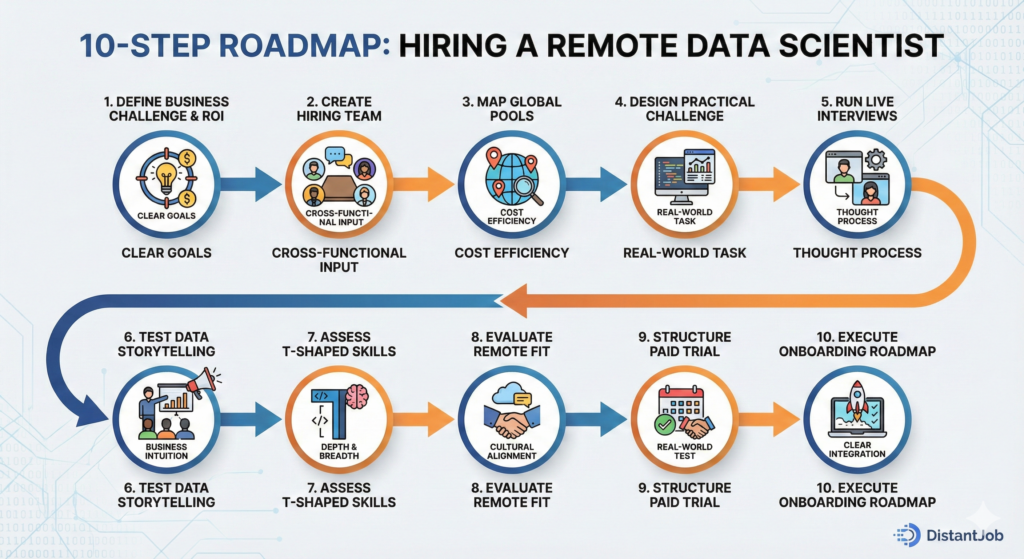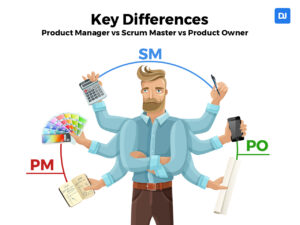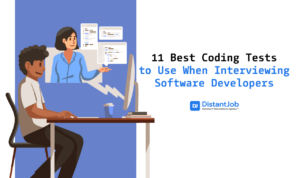Are you frustrated to see your customer numbers going down instead of up, and you feel like you’re quite often leaving money on the table? The truth is, when you make choices based on hunches and gut feelings or simple reports, you end up missing some of the biggest game-changing insights that are buried in your data. And that’s when you realize it’s actually time to bring in an expert and decide to go ahead and hire a data scientist—a true pro at problem-solving and analytical thinking that can truly turn your raw numbers into strategies that are smart and drive growth, the ones that get you ahead and help you stay there.
And here’s the truth of the matter: data scientists are in extremely high demand. According to the U.S. Bureau of Labor Statistics, they’re actually the fourth fastest-growing job and this demand is expected to increase by 36% from 2023 to 2033. And that just means that the race to get the best talent is actually tougher than you’d imagined. And that happens just because of the results they bring with their expertise, with 91.9% of companies stating they have seen real value from investing in data, as data-driven businesses are 23 times more likely to get new customers, 6 times more likely to keep them, and 19 times more likely to make a profit.

But how can you make sure you bring on board the right person who can have such a big impact? In this guide, we share expert, inside tips to help you spot, assess, and hire top-notch data science pros—so you can put together a first-rate team that sparks new ideas and boosts growth.
What is a Data Scientist?
A Data Scientist is an analytics professional who collects, analyzes, and interprets large datasets to solve complex business problems. They use skills in mathematics, statistics, and programming (Python, R, SQL) to build predictive models and machine learning pipelines that drive strategic decision-making.
Data Scientist Salary Comparison (2025)
| Region | Junior Data Scientist | Senior Data Scientist |
| North America (US) | $110,000 – $130,000 | $160,000 – $220,000+ |
| Western Europe | $60,000 – $85,000 | $90,000 – $120,000 |
| Latin America (Remote) | $40,000 – $60,000 | $70,000 – $95,000 |
| Eastern Europe (Remote) | $35,000 – $55,000 | $65,000 – $90,000 |
Data Scientist Skills and Qualifications
A data scientist’s skills will largely involve the reading, manipulation, and presentation of data. For that very purpose, they must be proficient in several fields and tools to work effectively:
- Mathematics
- Statistics and Statistical Analysis
- Data Mining
- Pattern Recognition and Predictive Modeling
- Programming (Java, Python, etc)
- SQL
- Analytics Tools and Platforms (Tableau, GoodData, etc)
- Office Tools (Spreadsheets and Presentations)
Data Scientist Roles and Responsibilities
Data scientists are responsible for generating value out of data. They are in charge of structuring and understanding massive amounts of data to provide insights and products. This helps businesses meet their needs, goals and automatize specific processes.
Their main responsibilities include:
- Select features, build and optimize classifiers using machine learning techniques.
- Identify valuable data sources and automate collection processes.
- Undertake data collection, preprocessing, and analysis.
- Analyze large amounts of information to discover trends or patterns.
- Propose solutions for the different challenges businesses face.
- Build predictive models and machine-learning algorithms.
- Present information and insights using data visualization techniques.
Data Scientist vs. Data Analyst
The main difference between a data scientist and a data analyst lies in the depth of data work and the goal of analysis. A data analyst explains what happened, while a data scientist predicts what will happen and why. Here’s a comparison table to understand it better:
| Feature | Data Analyst | Data Scientist |
| Primary Goal | Interpret existing data to answer specific business questions. | Build algorithms and models to predict future trends. |
| Key Skills | SQL, Excel, Tableau, PowerBI. | Python/R, Machine Learning, Hadoop, TensorFlow. |
| Math Focus | Descriptive Statistics. | Linear Algebra, Calculus, Predictive Modeling. |
| Output | Dashboards, Reports, Ad-hoc analysis. | Predictive Engines, Recommendation Systems, AIs. |
10-Step Plan for Hiring a Data Scientist
According to Glassdoor’s 50 Best Jobs in America report, data scientists are ranked as the second-best job across every industry based on the job openings, salary, and overall job satisfaction ratings.
If you’re looking to hire data scientists but don’t know where to start, here are 10 steps that will definitely help you attract and recruit the talent you’re looking for:

1. Define the Business Problem & ROI
Before you can start your data scientist hiring process, you need to have some basics down. So my suggestion is that you begin by asking yourself: “what specific measurable problem is holding my business back?” For example,it might be to cut customer churn by 10% in six months or boost forecast accuracy by 15%.
Once you know what your business challenge is, the next step is to use it to create your ideal candidate profile. Since you know what your new data scientist will be handling, it’s easier to pinpoint the specific technical, analytical, and business skills they will need.
In the end, you want someone who’s not just great at coding and data modeling, but can also turn complex insights into business strategies you and your teams can ultimately act on.
By following this step, you will be a lot closer to finding a data scientist who’ll make a real difference and deliver real impact instead of just meeting generic requirements and qualifications.
2. Create a Multi-Disciplinary Hiring Team
In order to assess their real impact on your business, it’s important to pull together a group of key people—leaders from operations, marketing, finance, and other departments—before you actually start interviewing your candidates. These professionals are the ones who can understand your company’s strategic goals and priorities, link them to their specific departments, and help you evaluate if what a candidate is bringing to the table is actually what their team needs and ultimately the company.
When you have your team together, make sure to give them clear guidelines for evaluation that go beyond just technical qualifications. Here are some aspects to consider:
- Alignment with Business Goals:
- Can the applicant’s method and approach directly address the challenge and tackle it (like reducing churn or improving forecasting)?
- Will their fix lead to clear, measurable results such as more increased revenue or cost savings?
- Teamwork Across Departments:
- Has the applicant shown they can work well with non-technical teams?
- Can they translate complex tech insights into actionable advice for different parts of the company?
- Growth and Lasting Effect:
- Is their suggested solution built to grow as your company does?
- Will it create space for sustainable solutions rather than just quick patches?
3. Source Candidates from Global Talent Pools
The facts speak for themselves when it comes to U.S. companies: Eastern Europe and Latin America are prime regions to find top-notch data scientists.
And the numbers tell the story: while the average U.S. data scientist makes about $126,443 a year—with pay hitting $136,934 in New York and $170,295 in San Francisco—Latin American data scientists earn between $36,000 and $60,000 yearly. This huge difference in their annual salary means you could save over 57% hiring in LatAm compared to hiring in the U.S. And let’s not forget Eastern Europe, since it also offers not only skilled but truly budget-friendly talent, with salaries like $43,000 in Bulgaria and around $70,000 in Poland.
What’s more, when you’re nearshoring with Latin American talent, you benefit from time zones that line up well with U.S. hours, which allows for real-time collaboration that is easy and seamless.
4. Design a Practical Data Challenge (Not Theory)
With the previous 3 steps in place, you can start focusing on truly assessing your potential new hires. And when it comes to evaluating data scientists, the first step to go about it is to work on a hands-on, practical task.
So instead of asking them abstract and theoretical questions, give them true practical assignments that actually reflect the challenges your business faces. And so you can make them even more real, ask them to work with actual or anonymized data to, (1) clean it, (2) build a predictive model, and then (3) turn their results into a clear, actionable plan.
In order to keep it simple, straightforward, and useful, we suggest you include specific questions such as “What factors do you think have caused customer churn, and how did you identify them?”. This way you can not only see their technical skills in action, but also their thought process when it comes to actual business problems.
5. Conduct Live Coding & Logic Interviews
After you’ve seen how your candidates were able to handle a custom and tailored data challenge (Step 4), it’s time you see them in action. To make that happen, invite your top picks to join a live session where they will have to guide you and other stakeholders through their approach—explaining their ideas and hypothesis, methods, and reasoning as they go.
During this meeting, throw in an unexpected twist—like a sudden fall in user activity and engagement. This will allow you to check if they pivot and how well and quickly they can do so. Ask them, for example, “How would you adjust your analysis if activity suddenly dropped?” Look for answers that show they can change their plan and still offer useful insights.
During these live meetings, focus on evaluating:
- Clear Articulation: Can they explain their thoughts and ideas in a simple and understandable way?
- Adaptability: How fast do they switch gears when faced with a new challenge or obstacle?
- Problem-Solving Under Pressure: Do they and can they come up with a new, revised plan that addresses the fresh situation head-on?
- Effective Communication: Are they engaging and able to simplify complex concepts and ideas for any crowd, especially the non-technical ones?
6. Assess “Data Storytelling” Skills
Let’s face it—when all is said and done, you need someone who can truly and actually transform your once messy data into clear wins for your company. So, while the previous steps have helped you check your candidates for technical skills, what ultimately counts for you is their ability to do the job they might get hired to do.
Here’s how you can see if they’re a good match for your company:
- Ask them to show you a straightforward, simple, and actionable plan: Get your data scientist candidate to explain how their model would fit into your current setup and operations. For example, you could ask them: “How would your method help us cut costs or increase sales?”
- Watch for clear, specific, and measurable steps: Pay attention if they are able to share concrete goals and numbers so you can see if they really understand what success means for your company specifically.
- Look at how they tell their story: Here’s where you check their storytelling and communication abilities, besides their analytical thought process. Can they actually break down their process in simple terms that make sense to both tech-savvy and non-tech team members?
- See how well they can change course: Ask them how they’d tweak their plan if something unexpected happened, like a big drop in how much users engage with your product.
- Check Their Business Direction: Make sure their answer isn’t all about the gadgets—it should link to real results, like cutting costs, boosting sales, or making work smoother.
7. Evaluate Cultural Fit & Remote Readiness
One important step of screening your data scientist candidates is to get to know their previous work. So at this step you should ask them to share a detailed breakdown of a project they’ve done before, and one that’s similar to your business problem.
In this breakdown, get them to talk about:
- Business Problem: What exact issue did they face, and why was it so important?
- New Ideas: What methods or tech did they use to solve the problem?
- Hurdles Cleared: How did they handle unexpected roadblocks or setbacks?
- Real Results: What concrete outcomes did they get (e.g. more money, less costs, better productivity)?
8. Verify Past Projects & Portfolio
If your data candidates have made it to this stage, it means their technical skills are up to par with what your business is looking for. But before you hire them, you need to make sure they have the right soft skills to work with your teams and are a cultural fit to your company.
To check this alignment, set up a casual and relaxed hang out or a low-key meeting where they can mingle with staff from different departments. This isn’t just a technical interview—it’s a chance for your team to talk about their projects, discuss their hobbies, and let the candidate ask questions.
Look out for signs such as:
- Clear, Simple Communication: Can they communicate clearly and openly, especially if English is not their first language?
- Team Chemistry: Do they appear at ease, friendly, and interested in what others are up to?
- Collaboration and Initiative: Are they eager to share their thoughts and ask smart questions that show they’d do well in your everyday work setting?
9. Structure a Paid Trial Period
Let’s say you’ve found a data candidate who looks like a great match for your team. But before you bring them on full-time why not give them a chance to show what they can do with a trial run?
Our suggestion to you is that you set up a 90-day period with clear goals instead of hiring them straight away. Much like a “test drive,” this trial period will allow you to see how they perform in real situations while giving the candidate a shot to prove they’re the right fit.
During this test run, you both have a chance to see if they can reach the goals you’ve agreed upon. You can even link part of their salary to these outcomes, which gives them a reason to make a real difference.
It’s good for everyone: you lower your risk by having clear milestones to check, and the applicant gets to show they can have an impact before the job becomes long-term.
10. Onboard with Clear KPIs
Your data scientist has gone through their 90-day trial with flying colors, which means it’s now time for you to bring them on as a full-time team member.
Make sure you begin by creating an onboarding plan that’s welcoming and straightforward at the same time. This plan should include and outline any upcoming projects information about your tech stack, besides scheduled check-ins with their mentor and key colleagues.
Keep in mind that this step goes a lot beyond just paperwork—it’s actually about helping them feel at ease by providing them with the necessary support, and showing them that they add value to your team’s success on a daily basis.
8 Interview Questions To Ask Your Data Scientist
Here are the best data scientist interview questions to test their knowledge and technical abilities.
1. What Are The Differences Between Supervised And Unsupervised Learning?
Supervised machine learning uses known and labeled data as input, and it has a feedback mechanism. The most commonly used supervised learning algorithms are decision trees, logistic regression, and support. On the other hand, unsupervised machine learning uses unlabeled data as input, and it doesn’t have a feedback mechanism. Its most commonly used algorithms are k-means, clustering, hierarchical clustering, and apriori algorithms.
2. Explain The Main Steps In Making A Decision Tree
There are 5 main steps in making a decision tree:
- Take the entire data set as input.
- Calculate entropy of the target variable and the predictor attributed.
- Calculate the information gain of all attributes.
- Choose the attribute with the highest information gain as the root node.
- Repeat the same procedure on every branch until the decision node of each branch is finalized.
3. What Are The Feature Selection Methods Used To Select The Right Variables?
There are two feature selection methods to select the right variables:
Filter methods involve linear discrimination analysis, ANOVA, and Chi-Square. When we’re selecting the features, it’s all about cleaning the data coming in.
Wrapper methods involve forward selection (to test one feature at a time), backward selection (test all the features and start removing them to see what works better), and recursive feature elimination (recursively look at all the different features and how they pair together).
4. What Does p-value Mean?
When you are performing a hypothesis test in statistics, a p-value can help you determine how strong your results are. p-value is a number between 0 a 1 and based on this value you’ll know the strength of the results. For instance:
- Low p-value (≤ 0.05) indicates strong evidence against the null hypothesis which means you can reject the null hypothesis.
- High p-value (≥ 0.05) indicates weak evidence against the null hypothesis, which means you can accept the null hypothesis.
- p-value at 0.05 is considered as marginal; you can both accept or reject the null hypothesis.
5. What Is A Random Forest?
A random forest is a versatile machine learning method that performs both regression and classification tasks. It involves creating multiple decision trees using bootstrapped datasets of the original data and randomly selecting a subset of variables at each decision tree step. The model then chooses the mode of all predictions of each decision tree.
By relying on a majority wins model, it reduces the risk of error from an individual tree.
Random forests offer several benefits such as strong performance, non-linear boundaries, cross-validation is not necessary, and gives feature importance.
6. You Randomly Draw A Coin From 100 Coins – 1 Unfair Coin (Head-head), 99 Fair Coins (Heat-tail), And Roll It 10 Times. If The Result Is 10 Heads, What Is The Probability That The Coin Is Unfair?
This can be answered using the Bayes Theorem. The extended equation for the Bayes Theorem is the following:

Assume that the probability of picking the unfair coin is denoted as P(A) and the probability of flipping 10 heads in a row is denoted as P(B).
P(B | A)= 1
P(B ∣ ¬A) = 0.5¹⁰ = 0.0009765625
P(A) is equal to 0.01
P(¬A) is equal to 0.99
If you fill in the equation, then P(A | B) = 0.9118432769 or ≈ 91.18%.
7. How Do You Handle Missing Data?
To handle missing data, the first step is to determine the percentage of data missing in a specific column. That way, it’s better to choose the appropriate strategy to handle the situation. For example, if most of the data is missing in a column, then dropping the column is the best option unless we have some means to make educated guesses about the missing values.
However, if the data missing is low, there are several ways to fill them up. One strategy is to fill them up with a default value or a value with the highest frequency in that column, such as 0 or 1, etc. Another way is to fill up the missing values in the mean of all the values in that column. This technique is the most popular one as the missing values have a higher chance of being closer to the mean than to the mode.
8. Explain cross-validations
Cross-validation is essentially a model validation technique used to evaluate how the outcomes of a statistical analysis will generalize to an independent data set. It’s mainly used in backgrounds where the objective is to forecast, and you want to estimate how accurately a model will accomplish in practice.
Recruit a Remote Data Scientist With DistantJob!
As you can see, bringing a data scientist on board is about making every number in your business count. And hiring not only one, but the right one for your business, comes down to having the strategy in place. By following the 10 steps shared in this article, you’ll surely be closer to hiring the data scientist that not only have what it takes technically, but also in terms of being able to turn their data into actual measurable wins for your business.
So, if through this sourcing and screening process, you spot a candidate who aces the technical stuff and can also turn their findings into concrete business results, know that you’ve struck gold.
If you want to hire a talented remote data scientist at an affordable price and as soon as possible, we’re your best option. As a boutique remote recruiting agency, DistantJob has been in the business for more than 10 years.
We know where the best IT candidates hide, and we know how to attract them by having the best IT recruitment strategy, so why don’t you leave this to us? Contact us, tell us all about your ideal data scientist, and in less than a month, you’ll be having an engineer with the right skills for the job role.
And if you are a data scientist looking for a job, feel free to contact us or to check our remote job openings board.






